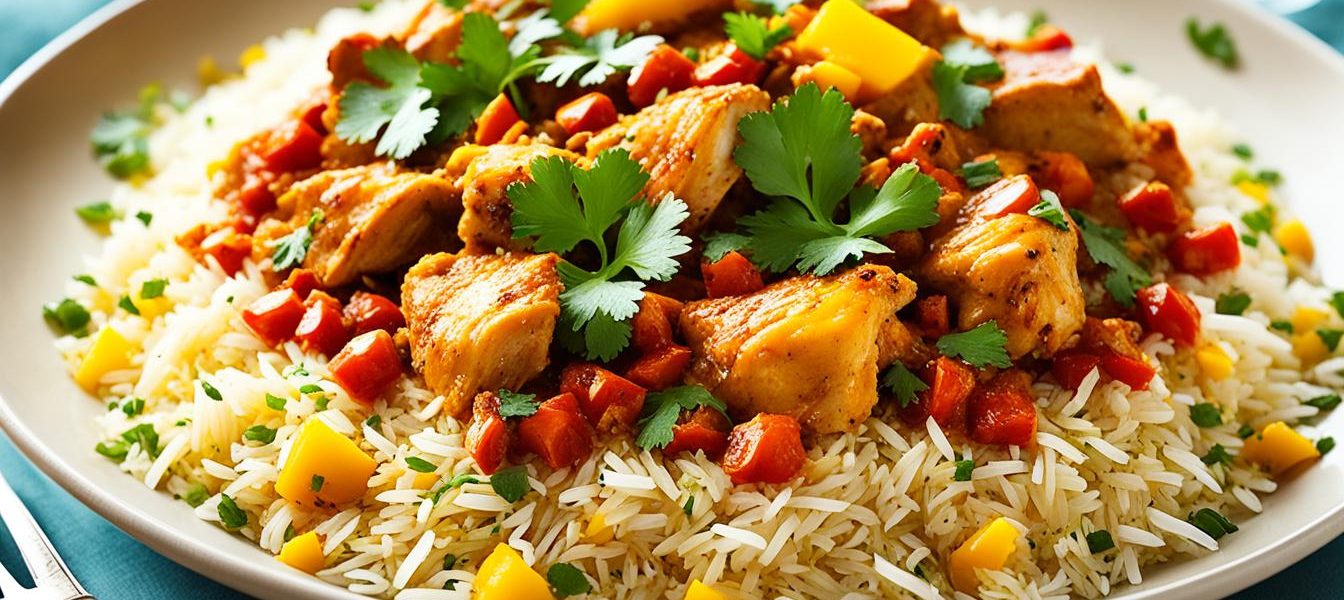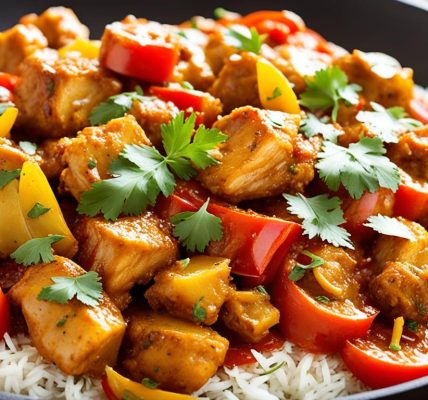Welcome to our blog post dedicated to one of the most beloved curries of all time – the Chicken Madras! If you’re a fan of authentic Indian cuisine, then this recipe is a must-try. With its rich flavors, fiery spices, and tender chicken, Chicken Madras is sure to satisfy your cravings for a spicy chicken curry.
Whether you’re a curry connoisseur or new to Indian cuisine, this recipe is perfect for anyone looking to explore the bold and vibrant flavors of this classic dish. Get ready to embark on a culinary journey as we guide you through the steps to create the best Chicken Madras recipe.
But before we dive in, let’s take a moment to understand why Chicken Madras holds a special place in the hearts of curry lovers worldwide. Its distinctive blend of spices and intense heat make it a standout dish that has become a favorite in Indian restaurants and households alike.
So, if you’re ready to embark on a flavor-packed journey, let’s get started and unlock the secrets of the best Chicken Madras recipe!
Ingredients for the Best Chicken Madras Recipe
To make the best chicken madras, you will need a carefully curated selection of ingredients that come together to create a tantalizing blend of flavors. Let’s take a closer look at the key ingredients:
- Chicken
- Onion
- Tomatoes
- Ginger and Garlic Paste
- Madras Curry Powder
- Red Chilli Powder
- Garam Masala
- Coconut Milk
- Lemon Juice
- Fresh Coriander
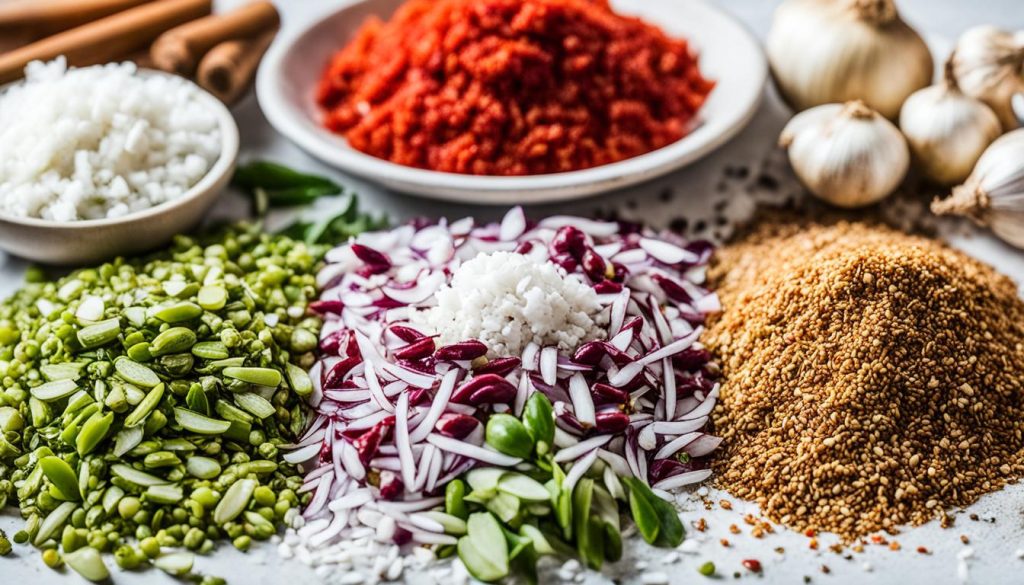
These ingredients come together harmoniously to create the authentic flavors of a chicken madras curry. Now that we have the list of ingredients, let’s move on to the next section to learn the step-by-step instructions to make this mouthwatering dish.
Instructions for Chicken Madras Recipe
Now that you have gathered all the ingredients, it’s time to dive into the step-by-step process of making a delicious chicken madras curry. Follow these instructions carefully to achieve an authentic and flavorful dish:
- Start by heating oil in a large pan over medium heat. Add onions and cook until they turn soft and golden brown.
- Next, add ginger and garlic paste to the pan and sauté for a minute until fragrant.
- Add the chicken pieces to the pan and cook until they are lightly browned on all sides.
- Now, it’s time to add the spices. Sprinkle in the chili powder, turmeric, coriander, cumin, and garam masala. Stir everything together to coat the chicken evenly with the spices.
- Pour in the chopped tomatoes and tomato puree. Mix well and let it simmer for a few minutes, allowing the flavors to meld together.
- To further enhance the spiciness and depth of the dish, add the red chili and curry leaves. Stir well and let it cook for another couple of minutes.
- Next, pour in the coconut milk and chicken stock. Stir gently to combine, then reduce the heat to low and let the curry simmer for about 30 minutes, or until the chicken is tender and cooked through.
- While the curry is simmering, you can prepare the rice or naan to serve alongside it.
- Once the cooking time is up, season the curry with salt according to your taste preferences. Remove from heat and let it rest for a few minutes before serving.
- Garnish with fresh coriander leaves and serve hot with steamed rice or warm naan bread.
Now that you know the step-by-step process of preparing a mouthwatering chicken madras curry, you can confidently make this flavorful dish in your own kitchen. Enjoy the aromatic spices and rich flavors that come together harmoniously in every bite.
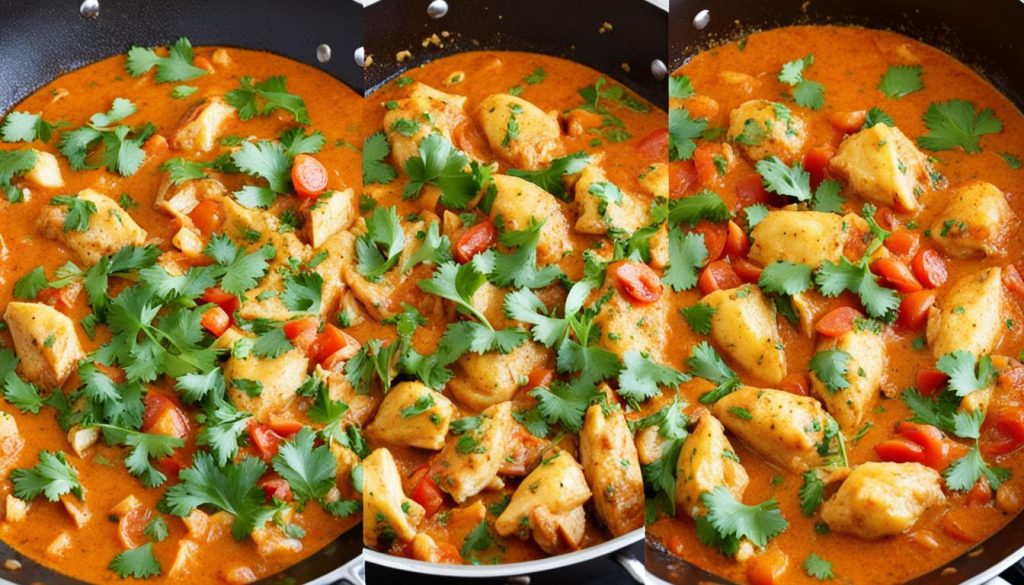
Nutrition Details of Chicken Madras Recipe
Understanding the nutrition information of your favorite dishes is vital for maintaining a balanced diet. Let’s take a closer look at the nutritional content of the chicken madras recipe.
The chicken madras provides a delicious blend of flavors, but it’s also important to consider its calorie content. A typical serving of chicken madras contains approximately calories in chicken madras (amount per serving may vary based on portion size and ingredients used).
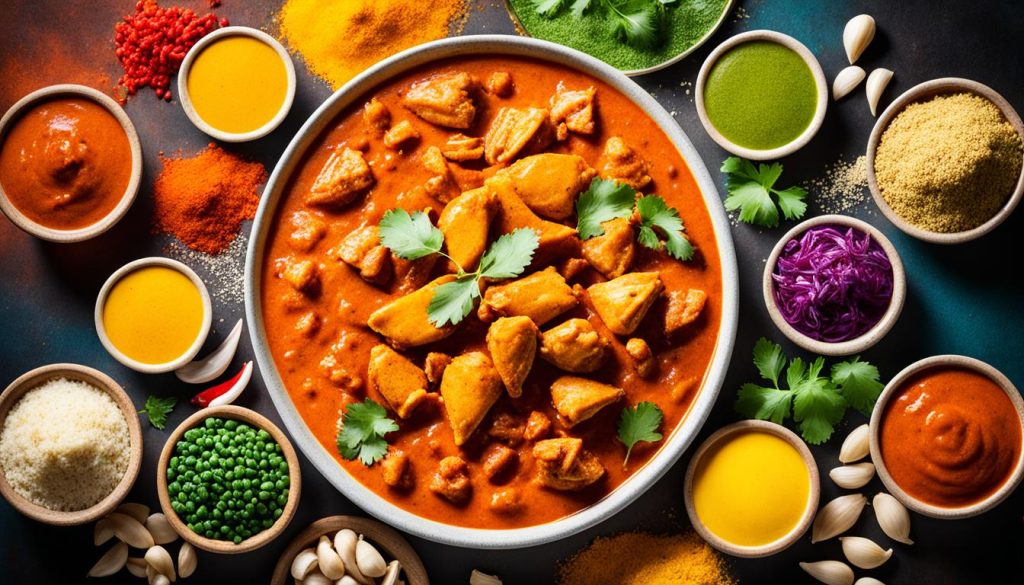
Macronutrients are essential for a healthy diet, and the chicken madras recipe offers a rich combination. Here’s a breakdown of the main macronutrients found in chicken madras:
- Protein: Chicken, the main ingredient in this dish, is an excellent source of protein. It provides the body with macronutrients in chicken madras essential for growth, repair, and overall health.
- Carbohydrates: The sauce in chicken madras is often made with tomatoes, onions, and spices. These ingredients contribute to the carbohydrate content of the dish, providing energy to fuel our daily activities.
- Fat: The addition of oil or ghee in the recipe adds flavor and richness to the chicken madras. While fats are calorie-dense, they are an important part of a balanced diet when consumed in moderation.
In addition to the macronutrients, chicken madras also contains a variety of vitamins and minerals. The spices and herbs used in the dish, such as turmeric, coriander, and cumin, offer their own unique nutritional benefits.
It’s worth noting that the nutritional composition may vary based on individual preferences and cooking methods. Using skinless chicken breast and reducing the amount of added fats can help create a healthier version of this classic dish.
By understanding the nutrition details of chicken madras, you can make informed choices about incorporating it into your meal plan. Remember, moderation and balance are key to a healthy and enjoyable diet.
Variations of Chicken Madras Recipe
When it comes to chicken madras, there are numerous variations that can be explored to elevate the flavors and meet individual preferences. From adjusting the spice level to incorporating unique ingredients, here are some exciting ways to shake up your chicken madras recipe:
1. Spicy Variations
If you like your chicken madras extra hot and spicy, there are a few ways to achieve that fiery kick. Consider adding an extra teaspoon of chili powder or fresh chilies to amp up the heat. For those who prefer a milder spice, reduce the amount of chili powder or use milder chili varieties.
2. Regional Twists
Chicken madras is known for its regional variations throughout India. Experiment with different techniques and ingredients from various regions to create unique and authentic flavors. For example, you can incorporate coconut milk for a creamy South Indian-style madras or use tamarind pulp for a tangy twist inspired by the coastal regions.
3. Ingredient Additions
To add depth of flavor and variety to your chicken madras, try incorporating additional ingredients. Consider adding vegetables like bell peppers or spinach for added nutrition and texture. You can also experiment with spices like fenugreek leaves or mustard seeds to enhance the overall taste.
4. Creamy Variations
If you prefer a richer and creamier chicken madras, try adding a dollop of yogurt or coconut cream to the recipe. This will not only add a luscious texture but also help balance the spices and provide a cooling effect. Don’t forget to adjust the seasoning accordingly to maintain the perfect balance.
With these chicken madras variations, you have the freedom to tailor the recipe to suit your taste preferences. Experimentation is key, so don’t be afraid to get creative in the kitchen!
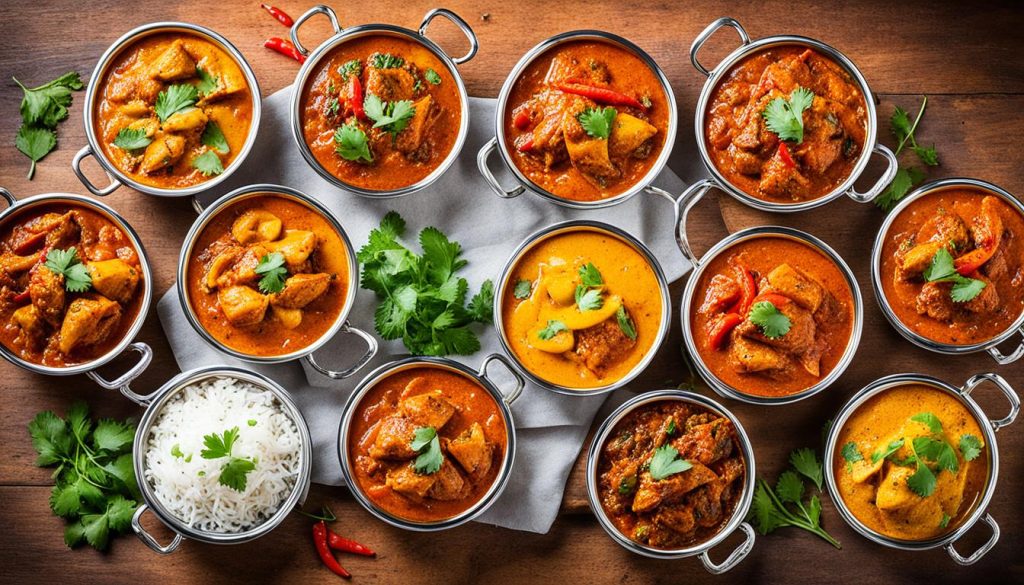
Preparation and Cooking Time
Before you embark on making your delicious chicken madras, it’s helpful to have an understanding of the time required for preparation and cooking. By knowing how long each step takes, you can plan your cooking process more efficiently.
To start, the preparation time for chicken madras will vary depending on your experience in the kitchen and the availability of pre-prepared ingredients. On average, it takes approximately 15-20 minutes to gather and prep all the necessary ingredients. This includes chopping the chicken, onions, garlic, and ginger, as well as measuring the spices and other seasonings. Having everything organized and ready before you start cooking will streamline the process and keep everything running smoothly.
Once you have completed the preparation stage, it’s time to move on to the cooking. The cooking time for chicken madras can range from 30-40 minutes. This includes sautéing the onions, garlic, and ginger, browning the chicken, and simmering the sauce to allow the flavors to meld together. It’s important to cook the chicken thoroughly to ensure it’s safe to eat, so make sure to check that it’s cooked through before serving.
It’s worth noting that these times are estimates and can vary depending on factors such as the size and thickness of the chicken pieces, the heat of your stovetop, and your personal preferences for the level of spiciness. It’s always a good idea to keep an eye on your dish as it cooks and adjust the heat and cooking time as needed.
When planning your meal, remember to factor in any additional time for side dishes, such as rice or naan bread, that you may be serving with your chicken madras. It’s also a good idea to allow a few minutes of resting time for the flavors to fully develop before serving.
Now that you have an idea of the time required to make chicken madras, you can plan your cooking process accordingly. Enjoy the journey of creating this delicious dish and savor the aromatic flavors!
Serving Suggestions
Now that you have cooked up a delicious batch of chicken madras, it’s time to think about how to serve it and what to pair it with. Here are some serving suggestions and reheating tips to enhance your dining experience:
When it comes to serving chicken madras, there are a few classic accompaniments that never disappoint:
- Fragrant Basmati Rice: Serve a generous portion of chicken madras over steaming hot basmati rice for a satisfying meal.
- Naan Bread: Tear off a piece of warm and fluffy naan bread and use it to scoop up the tender chicken and rich sauce.
- Mango Chutney: Add a dollop of sweet and tangy mango chutney on the side to complement the spicy flavors of the dish.
These traditional accompaniments perfectly balance the heat and richness of the chicken madras, creating a harmonious blend of flavors on your plate.
Reheating Tips
If you find yourself with leftovers, don’t worry! Chicken madras can be just as delicious when reheated properly. Follow these tips to ensure the best flavor and texture:
- Stovetop: Transfer the chicken madras to a saucepan and gently reheat it over low heat, stirring occasionally, until it reaches your desired temperature.
- Microwave: Place the chicken madras in a microwave-safe dish and cover it with a microwave-safe lid or microwave-safe wrap. Heat it in short intervals, stirring in between, until it is thoroughly heated.
- Oven: Preheat your oven to a low temperature (around 300°F/150°C). Transfer the chicken madras to an oven-safe dish, cover it with foil, and heat it for about 15-20 minutes until it is warmed through.
Remember to always stir the chicken madras during reheating to ensure even heat distribution. Additionally, you can add a splash of water or chicken broth if the dish seems dry after reheating.
With these serving suggestions and reheating tips, you can enjoy the delectable flavors of chicken madras time and time again, whether you are serving it fresh or reheating it for a delicious leftover meal.
Homemade Chicken Madras vs. Restaurant-Style: What’s the Difference?
When it comes to chicken madras, there are two main options to consider – homemade and restaurant-style. While both versions of this popular curry dish have their merits, they also have distinct differences that may influence your preference. In this section, we’ll explore the contrasts between homemade and restaurant-style chicken madras, highlighting the variations in flavor, ingredients, and cooking techniques.
Let’s start with the homemade version. The key advantage of making chicken madras at home is the ability to customize the dish according to your taste preferences. You have complete control over the ingredients, allowing you to adjust the spice level, sweetness, and richness to suit your palate. Additionally, preparing chicken madras from scratch gives you the freedom to experiment with different spices and spice blends, resulting in a unique and personalized flavor.
On the other hand, restaurant-style chicken madras offers a distinct experience. Restaurants often use traditional recipes passed down through generations, ensuring an authentic and consistent flavor profile. The use of professional-grade cooking techniques and specialized equipment can elevate the dish to another level, creating a restaurant-quality taste that is hard to replicate at home.
Conclusion
After exploring the ingredients, instructions, nutrition details, variations, preparation and cooking time, serving suggestions, and the difference between homemade and restaurant-style chicken madras, it’s evident that this curry is a true favourite among curry enthusiasts. The chicken madras recipe offers a balance of rich flavours, spices, and heat, resulting in a delicious and satisfying dish.
By following the step-by-step instructions provided, anyone can easily recreate this authentic Indian curry at home. The recipe allows for customization, enabling individuals to adjust the spice levels and add their own twist to suit their preferences. With its versatility, chicken madras can be enjoyed with rice, naan bread, or any other accompaniment of choice.
In conclusion, the chicken madras recipe provides a winning combination of tantalizing aromas and unforgettable tastes. Whether enjoyed as a satisfying home-cooked meal or savoured at a local Indian restaurant, chicken madras is sure to please even the most discerning curry connoisseurs. So why not give it a try and experience the magic of this beloved dish for yourself?
FAQs
What is chicken madras made of?
Chicken madras is made with a combination of ingredients including chicken, onions, tomatoes, garlic, ginger, and a blend of spices such as turmeric, cumin, coriander, paprika, and chili powder.
What is the difference between curry and madras?
The main difference between curry and madras is the level of spiciness. Madras curry is generally spicier than regular curry and often contains a higher amount of chili powder or other hot spices.
What is madras cooking sauce?
Madras cooking sauce is a ready-made sauce that contains a blend of spices and ingredients commonly used in madras curry. It can be used as a shortcut for making chicken madras or other dishes.
What is the flavor of madras?
Madras curry has a rich and robust flavor profile with a combination of spicy, tangy, and earthy notes. It is known for its intense heat, deep red color, and complex blend of spices.
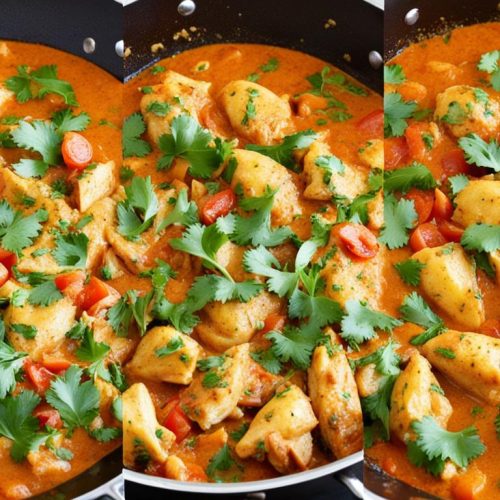
Chicken Madras Recipe
Ingredients
- Chicken
- Onion
- Tomatoes
- Ginger and Garlic Paste
- Madras Curry Powder
- Red Chilli Powder
- Garam Masala
- Coconut Milk
- Lemon Juice
- Fresh Coriander
Instructions
- Start by heating oil in a large pan over medium heat. Add onions and cook until they turn soft and golden brown.Onion
- Next, add ginger and garlic paste to the pan and sauté for a minute until fragrant.Ginger and Garlic Paste
- Add the chicken pieces to the pan and cook until they are lightly browned on all sides.Chicken
- Now, it's time to add the spices. Sprinkle in the chili powder, turmeric, coriander, cumin, and garam masala. Stir everything together to coat the chicken evenly with the spices.Madras Curry Powder, Red Chilli Powder, Garam Masala, Lemon Juice
- Pour in the chopped tomatoes and tomato puree. Mix well and let it simmer for a few minutes, allowing the flavors to meld together.Tomatoes
- To further enhance the spiciness and depth of the dish, add the red chili and curry leaves. Stir well and let it cook for another couple of minutes.
- Next, pour in the coconut milk and chicken stock. Stir gently to combine, then reduce the heat to low and let the curry simmer for about 30 minutes, or until the chicken is tender and cooked through.Coconut Milk
- While the curry is simmering, you can prepare the rice or naan to serve alongside it.
- Once the cooking time is up, season the curry with salt according to your taste preferences. Remove from heat and let it rest for a few minutes before serving.
- Garnish with fresh coriander leaves and serve hot with steamed rice or warm naan bread.Fresh Coriander

